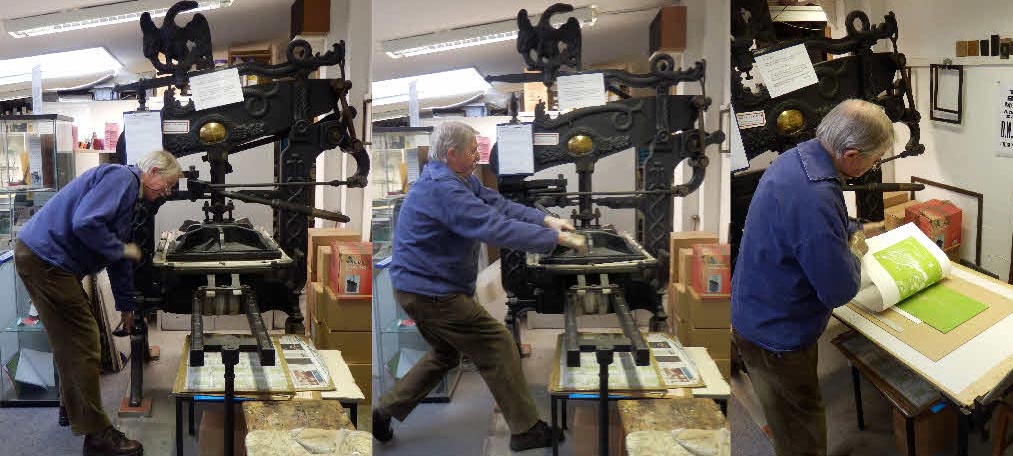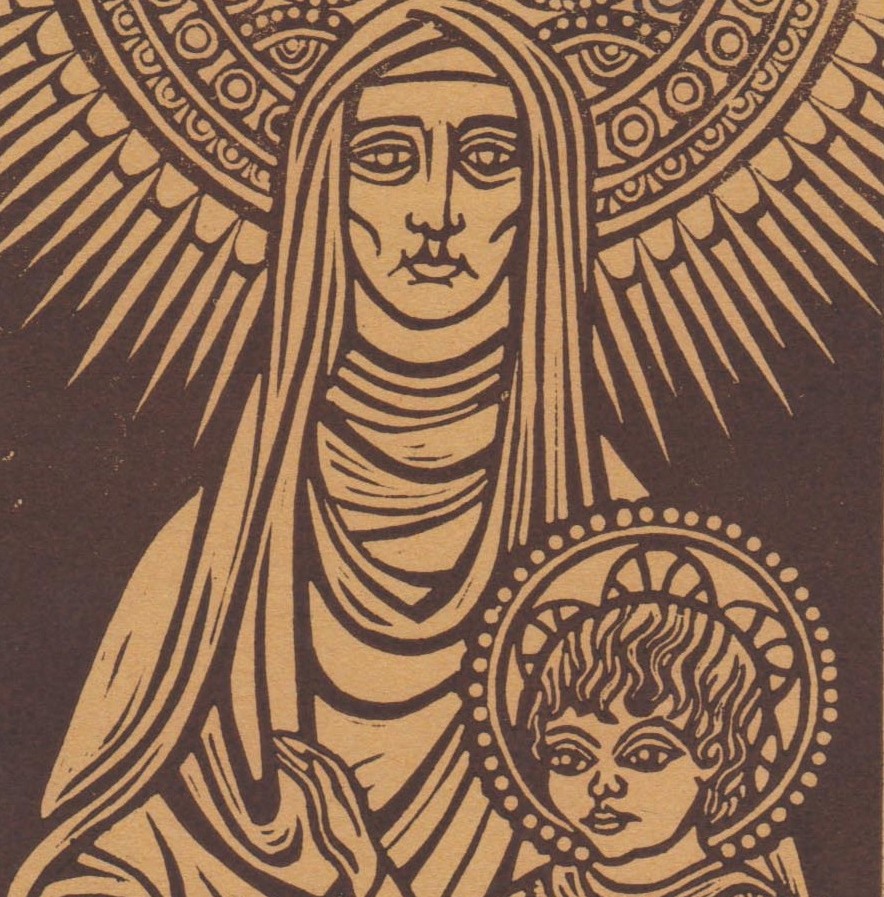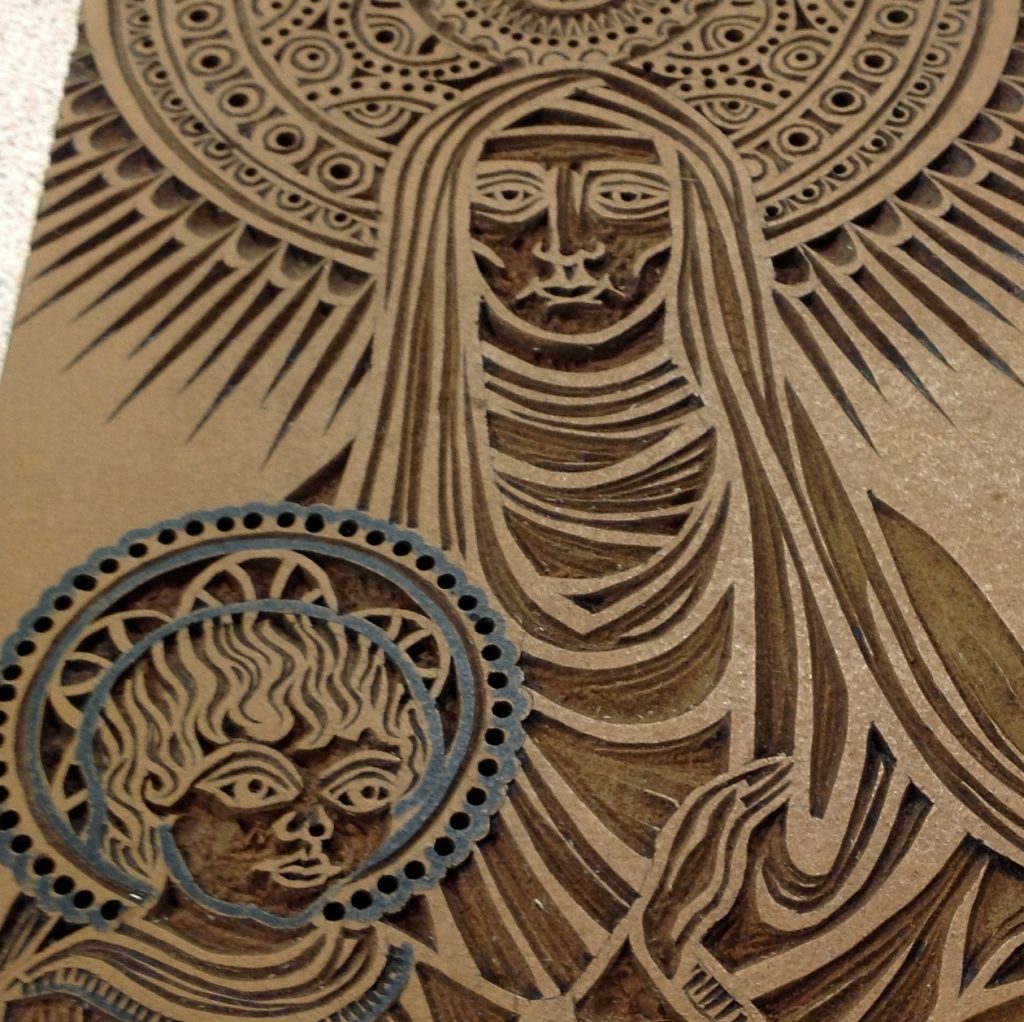
Fifty-Eight Years of Christmas Card-making
When, in November 1962, in my final year as an Art student, having trained in stained glass under the tutelage of Howard Martin and in lithography with Arthur Charlton, I thought it would save money if I made my own Christmas cards.I little realised then what I was getting into. That first year, I produced a small edition of around two dozen, using the lithographic technique.
The following year, in my first term of teaching, I was presented with some lino and a set of cutting tools by my Head of Department, with some words of encouragement. I produced a plagiarised version of a superb mosaic of an angel which I’d seen in the new Coventry Cathedral while researching for my thesis. I had never tried my hand at lino-cutting previously, not even at Swansea Grammar School, but after the first tentative cuts with a fine gouge I was hooked and I learned to love the technique.
Over the years, my Christmas cards have been mainly lino-cuts with, occasionally, some scraper board designs and once a pencil drawing. Searching for inspiration, I cheerfully plagiarised the works of Giotto and Fra Angelico for basic ideas, though I always tried to make them my own.
Gradually, year on year, the Christmas card list grew and I eventually succumbed to the realisation that I needed to get my work printed commercially. And, instead of making just single colour prints, it meant I was also able to use colour. As we send well over 100 cards each year, it has become a somewhat expensive business when production and postage costs are factored in, thus defeating my initial intention all those years ago.
Nevertheless, since I enjoy my annual commitment so much, I am determined to carry on as long as my eyesight holds up and arthritis keeps at bay.
Alan Figg, 2020

Fifty-five Years of Christmas Card-making | Gill Figg
This article appeared in the magazine for Friends of the Glynn Vivian Gallery, Swansea in 2017
It all began in 1962. In his final year as a student at Swansea Art College, Alan Figg made his first Christmas card. It was a small lithograph of the Annunciation. He printed a couple of dozen to give to family and a small circle of friends. It was the start of a life-long practice.
The following year found him teaching art in Portchester Boys’ Bi-lateral School in Bournemouth. His Head of Department, Neil Grant, gave him a set of lino tools which had been left behind by the previous incumbent and Alan made his first linocut Christmas card (‘Unto Us’). The design was based on a mosaic he had admired in the recently re-built Coventry Cathedral.
After three years teaching in Bournemouth, during which he continued to produce his hand-printed linocuts each Christmas, he returned to Swansea to teach in Townhill Secondary Modern School for Boys. By now he was a married man and a new father. He had been very happy in Bournemouth under the benign patronage of Neil and his wife, Helen.They showed him not only how to teach art, but also how to enjoy life and appreciate fine wine. Nevertheless, the pull of Swansea and, in particular, the enchantment of Gower,was too strong: he and his little family returned to the Ugly Lovely Town.
In spite of the considerable demands of teaching, Alan still managed to produce a Christmas card every year. The cards were printed on a small press during playtimes, assisted by a willing band of boys – refugees from the boisterous bullying of the school yard. Unfortunately, Christmas card production coincided with end-of-term reports and the two things together necessitated the burning of a great deal of midnight oil. By some miracle, the boys got their reports (just) in time, but friends and family who lived further afield than a two-mile radius of home more often than not received their cards several days after Christmas, courtesy of the Royal Mail. They became known as Epiphany cards.
The designs were mainly along Biblical themes – the Nativity; the journey of the Magi; angels and more angels; shepherds and their sheep; the little town of Bethlehem. Alan’s training in stained glass shone through, both in the stylisation of the figures and in the way they fitted into the given shape. Occasionally there would be a piece of decorative calligraphy and, on one occasion only, a pencil drawing (obviously a bit of a rush job that year).Christmas carols provided ideas too: ‘I Saw Three Ships Come Sailing in’; ‘And all the birds on earth took wing.’
By the early nineties, the Christmas card list was running to well over a hundred and it became apparent that a commercial printer would be needed to deliver the required number. This took the pressure off and it also meant that the image could be reduced in size, so that envelopes could be smaller and, consequently, postage not so costly. Some of the original lino prints have been editioned for exhibition in various art galleries and bought by collectors. The cards themselves are also available for purchase in a number of outlets, including the Swansea Print Workshop, of which Alan is a Director.
The year 2015 saw a departure from mainly religious themes with a wood engraving of a robin: a new technique and a secular subject. It was the Year of the Robin – voted the nation’s favourite bird. This was followed last year by a linocut of a partridge in a pear tree – the start of a new series, which should provide a challenge for a number of years to come.
What started out as a fairly modest undertaking has developed into something of a minor obsession. Only war and pestilence will prevent Alan Figg from making his annual Christmas card. Many of our friends tell us that they keep all the cards they have received, some even bringing the collection out of storage to display every year at Christmas. Sadly, it seems that fewer people send cards these days, preferring to use email or other ways to send their greetings. However, I can safely prophesy that, as long as he is able, Alan Figg will keep on making his own. I look forward to seeing how he will cope with Twelve Drummers Drumming. That should test his powers of design not to mention his lino-cutting technique. He will be 92 by then.How’s that for optimism?

